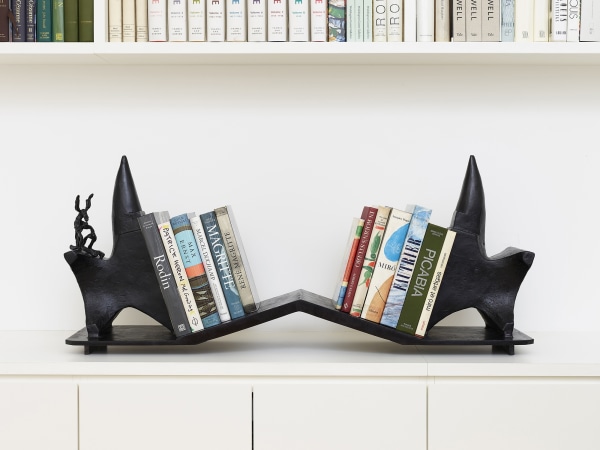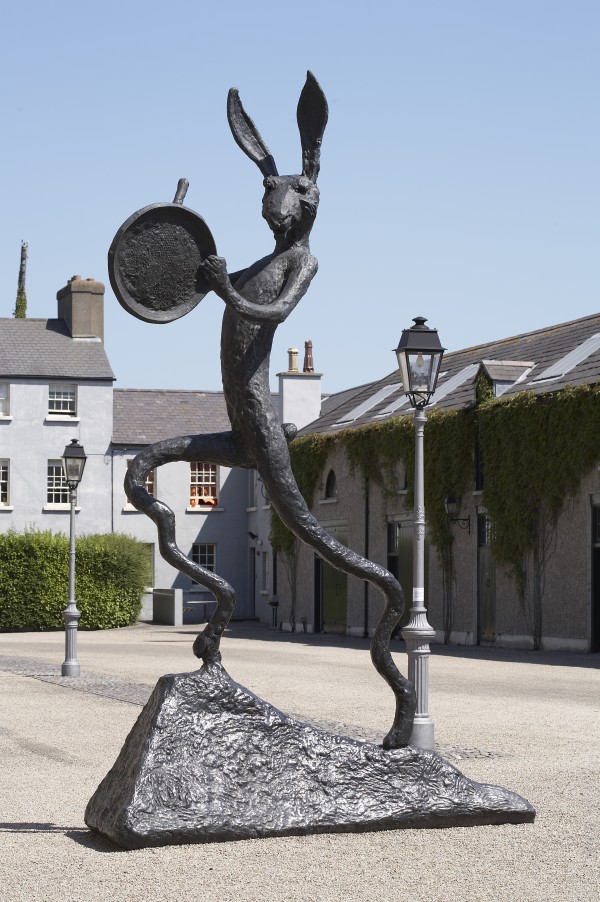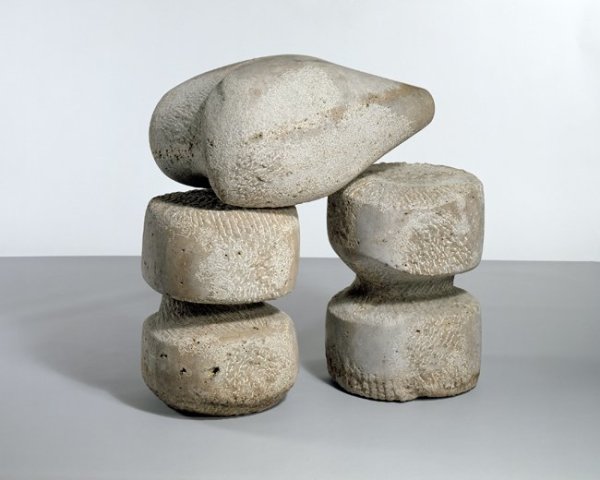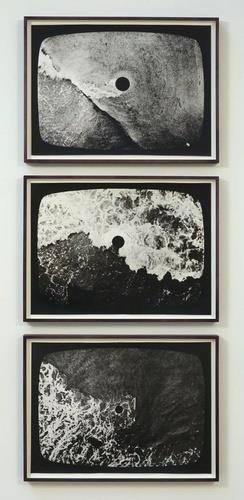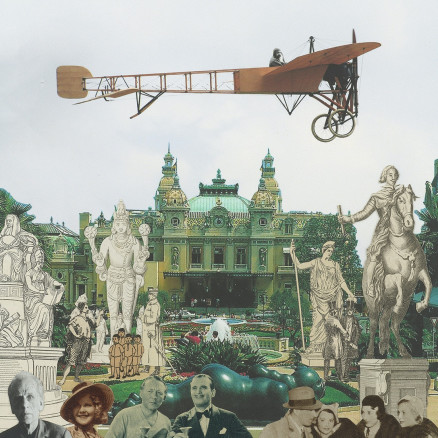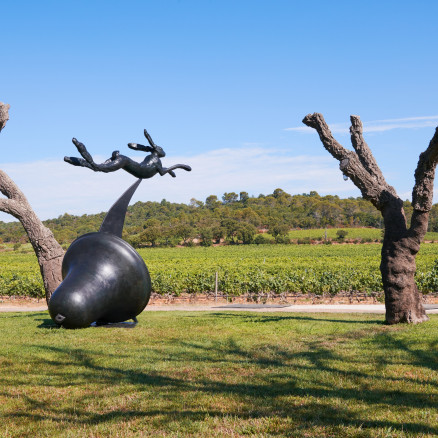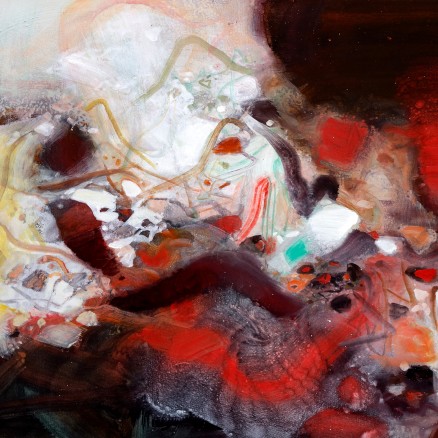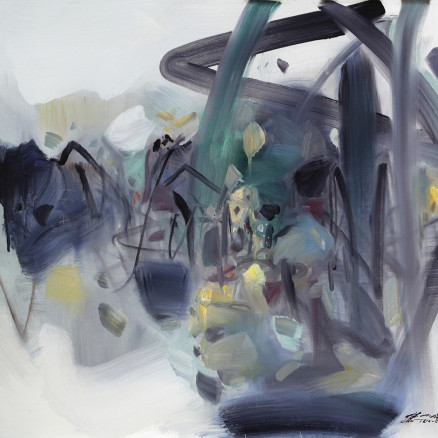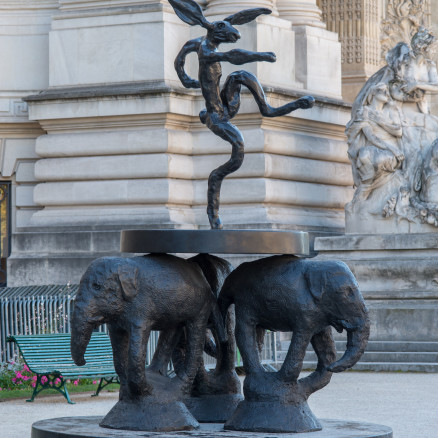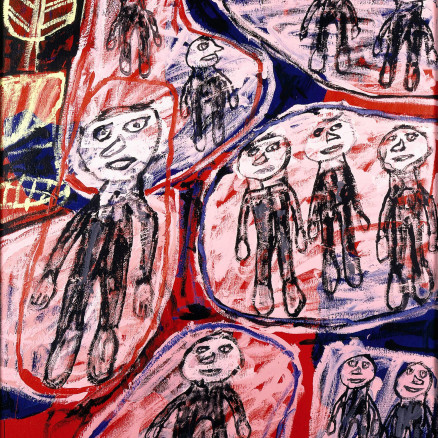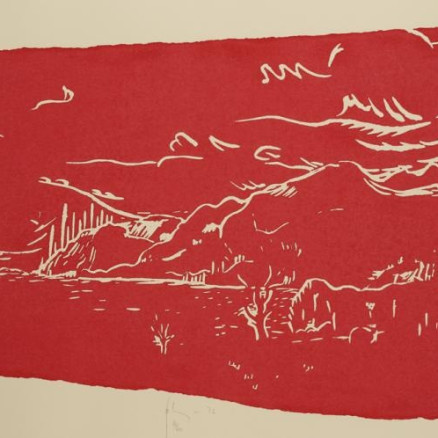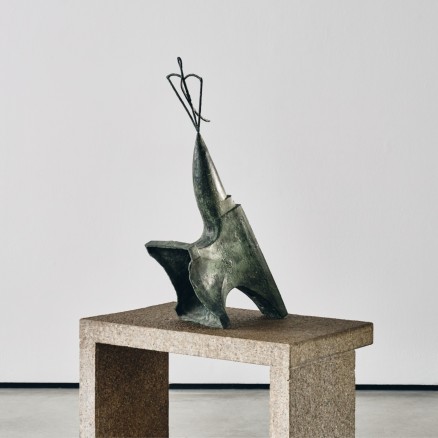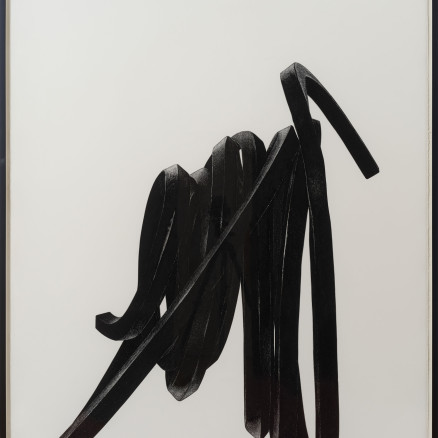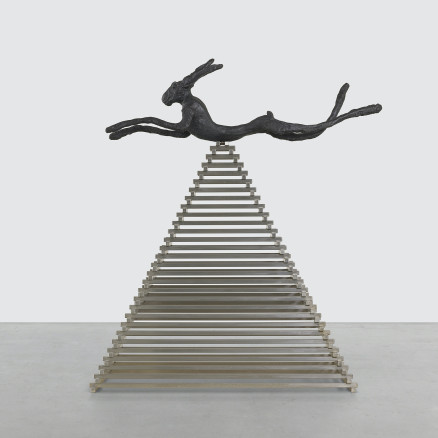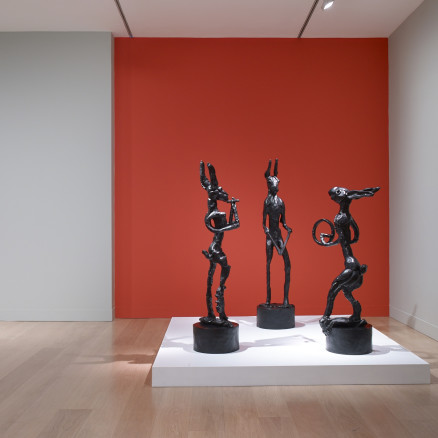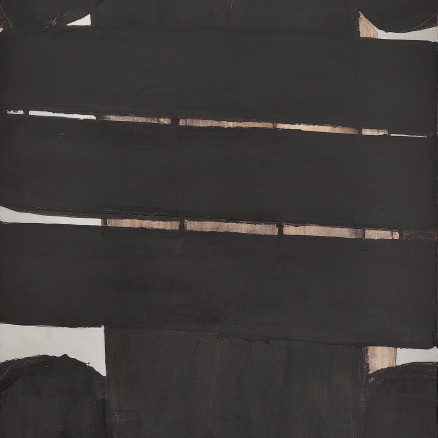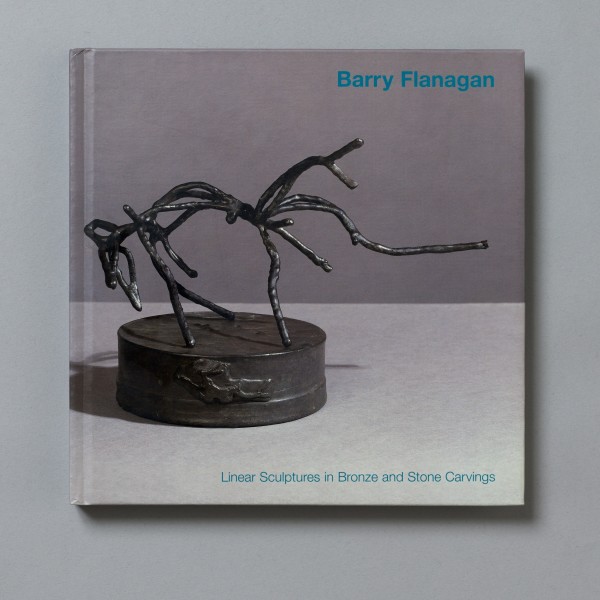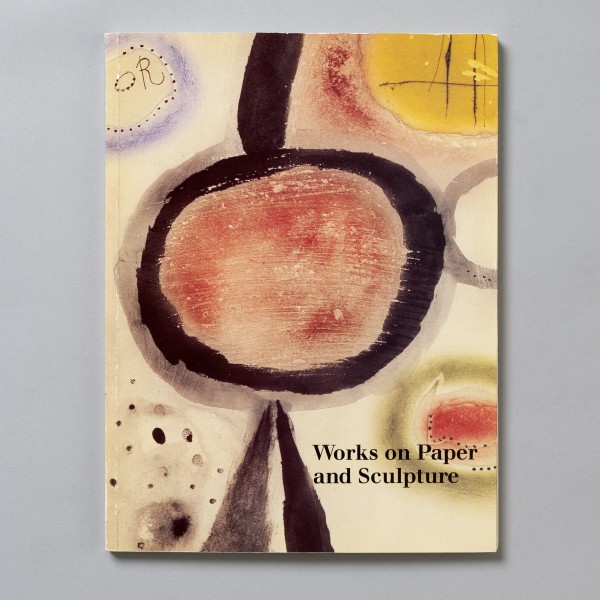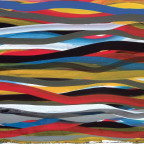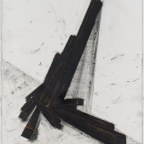Biography
Barry Flanagan (b.1941, Prestatyn, Wales; d.2009, Ibiza) is one of Britain’s most significant sculptors, and also one of its most loved. Having studied architecture at Birmingham College of Art and Crafts and, after spells at different colleges, Flanagan was offered a place on the Vocational Diploma in Sculpture at St. Martin’s School of Art, London in 1964. After graduating in 1966, Flanagan went on to teach at St. Martin’s as well as at the Central School of Arts and Crafts between 1967 and 1971. In 1991 he was elected to the Royal Academy, and he received the OBE.
From the outset, Flanagan’s work was perceived as radical and independent. He revolutionised sculptural material when in 1965, while still a student, he showed the soft sculpture ‘aaing j gni aa’ (1965) [bought by the Tate Gallery in 1969] at Better Books, Charing Cross Road, which changed ideas about the language of sculpture forever. Flanagan was interested in ‘pataphysics’ – Alfred Jarry’s ‘science of imaginary solutions’ – an ethos evident in his playful approach, which allows materials to find their own sculptural form, whether sand or rope, stone, sheet metal, cloth, clay or bronze. He was included in the exhibition, ‘Between Poetry and Painting’ at the ICA (also in 1965) and contributed a finger poem, one of many examples of concrete poetry in the exhibition. His first solo exhibition was held at the Rowan Gallery, London in 1966. His first solo exhibition at Waddington Galleries, London was held in 1980.
It is with frequent warmth and wit that animals of all sorts populate Flanagan’s oeuvre; hares, elephants, dogs and horses, moulded first in clay and then cast into bronze, fuse the everyday, the imaginary and the fantastical. Within this menagerie, Flanagan is perhaps best known for his dynamic and often monumental bronze hares, which spring into life as one of his most important characters and were first exhibited in the early eighties. Presented in all manner of poses in a variety of sizes and combinations; among bronzes made over 30 years, one can find hares boxing, dancing, leaping and philosophising, all a comment on the archetype of classical sculpture.
When asked about his hare motif, Flanagan would describe the magical experience of seeing a hare running on the Sussex Downs. This event prompted his first ‘Leaping Hare’ sculpture, conceived in 1979. For the Egyptians, the hare represented life. In Chinese mythology, the hare is the inhabitant of the moon and the symbol of immortality. In addition to the nexus of mythological meanings attributed to hares, it was, in the end, the hare’s anthropomorphic potential that held the most fascination for Flanagan; it came to stand as a surrogate human figure and a metaphor for the artist’s own elusive character. Overall, Flanagan found something deliciously contradictory in taking an elusive creature associated with speed and transience and casting it in bronze, a weighty material that implies permanence and solidity.
Flanagan’s return to bronze (he had previously cast work in the foundry at Central School of Art with Henry Abercrombie in 1969) was a continuation of his exploration into different media; from the early sand, rope and cloth pieces, which focused on composition, to the ceramic, stone, marble and sheet metal sculptures of the seventies. He was also involved in happenings and dematerialised practices. In 1966 he collaborated with Yoko Ono and in 1980 with the Marjorie Strider dance company. Like his contemporaries from St. Martin’s School of Art – Richard Long, Gilbert & George and Bruce McLean – Flanagan experimented with film; his film ‘A hole in the Sea’ (1969) was included in Land Art, Gerry Schum’s seminal Fernseh-Galerie film.
The 1979 exhibition ‘The Horses of San Marco’ at the Royal Academy of Arts, London made a deep impression on Flanagan. Abercrombie described the exhibition’s impact on Flanagan’s thinking and approach to sculpture, where the sheer tactile physicality of the ancient modelled horses created an aura and majesty. The varied patinas and gilding also provided substantial material to investigate the properties of bronze. As a result, Flanagan imbued each of his bronze horse sculptures with a distinctly different character, for instance the beautiful majestic and powerful ‘Horse’ (1983) at Jesus College, Cambridge to the gentle diffidence of ‘Field Day’ (1986), also known as the ‘Korus Horse’ in San Eulalia, Ibiza and the mysterious, mythological qualities of the ‘Unicorn and Oak Tree’ (1991).
Flanagan represented Britain at the Venice Biennale in 1982. A major retrospective of his work was held at the Fundación ‘La Caixa’ Madrid (1993), touring to the Musée des Beaux-Arts, Nantes (1994). Flanagan’s bronze hares have also been exhibited in many outdoor spaces, including on Park Avenue in New York (1995–6) and at Grant Park, Chicago (1996). In 1999, he had a solo exhibition at Galerie Xavier Hufkens in Brussels, followed by an exhibition at Tate, Liverpool (2000). In 2002, a major exhibition of his work was shown at the Kunsthalle Recklinghausen, Germany, touring to the Musee d’Art Moderne et d’Art Contemporain, Nice. In 2006, the Irish Museum of Modern Art in Dublin held a major retrospective of his work, in association with Dublin City Art Gallery The Hugh Lane, which included ten large-scale bronzes installed along O’Connell Street and Parnell Square. Recent major exhibitions include Beyond Limits at Chatsworth House, Derbyshire (2012); Barry Flanagan Sand Girl, Tate Britain, London (2016); Barry Flanagan, Hong Kong Convention Centre (2019); Barry Flanagan, IKON, Birmingham (2019); Alchemy of the Theatre, Waddington Custot, London (2020); In Contemplation, Gow Langsford Gallery, Auckland, New Zealand (2022); Imaginary Solutions, Galerie Max Hetzler, Berlin (2023); and Sculpture is Always Going On at Galerie Max Hetzler, Berlin (2024). Flanagan’s monumental bronze work ‘Large Nijinski on Anvil Point’ was exhibited in London’s Berkeley Square as part of Art of Mayfair, a celebration of Mayfair’s vibrant cultural scene, in June 2023. Flanagan’s work is held in numerous public collections worldwide, including Museum of Modern Art, New York; Metropolitan Art Museum, Tokyo; Centre Georges Pompidou, Paris; and Tate, London.
Works
-
 Barry Flanagan, Installation on Cork Street, London, 2020
Barry Flanagan, Installation on Cork Street, London, 2020
-
 Barry Flanagan, Installation image, Retrospective at Ikon, Birmingham, 2019
Barry Flanagan, Installation image, Retrospective at Ikon, Birmingham, 2019
-
 Barry Flanagan, Book Ends, 2001
bronze
54.6 x 127 x 29.8 cm
%3Cdiv%20class%3D%22artist%22%3E%3Cspan%20class%3D%22artist%22%3E%3Cstrong%3EBarry%20Flanagan%3C/strong%3E%3C/span%3E%3C/div%3E%0D%3Cdiv%20class%3D%22title%22%3E%3Cem%3EBook%20Ends%3C/em%3E%2C%202001%3C/div%3E%0D%3Cdiv%20class%3D%22medium%22%3Ebronze%20%3C/div%3E%0D%3Cdiv%20class%3D%22dimensions%22%3E54.6%20x%20127%20x%2029.8%20cm%3C/div%3E
Barry Flanagan, Book Ends, 2001
bronze
54.6 x 127 x 29.8 cm
%3Cdiv%20class%3D%22artist%22%3E%3Cspan%20class%3D%22artist%22%3E%3Cstrong%3EBarry%20Flanagan%3C/strong%3E%3C/span%3E%3C/div%3E%0D%3Cdiv%20class%3D%22title%22%3E%3Cem%3EBook%20Ends%3C/em%3E%2C%202001%3C/div%3E%0D%3Cdiv%20class%3D%22medium%22%3Ebronze%20%3C/div%3E%0D%3Cdiv%20class%3D%22dimensions%22%3E54.6%20x%20127%20x%2029.8%20cm%3C/div%3E -
 Barry Flanagan, The Drummer: Installation at IMMA, Dublin, 1996
Barry Flanagan, The Drummer: Installation at IMMA, Dublin, 1996
-
 Barry Flanagan, Baby Elephant, 1984
bronze
174.6 x 104.1 x 62.2 cm
%3Cdiv%20class%3D%22artist%22%3E%3Cspan%20class%3D%22artist%22%3E%3Cstrong%3EBarry%20Flanagan%3C/strong%3E%3C/span%3E%3C/div%3E%0D%3Cdiv%20class%3D%22title%22%3E%3Cem%3EBaby%20Elephant%3C/em%3E%2C%201984%3C/div%3E%0D%3Cdiv%20class%3D%22medium%22%3Ebronze%3C/div%3E%0D%3Cdiv%20class%3D%22dimensions%22%3E174.6%20x%20104.1%20x%2062.2%20cm%3C/div%3E%0D%3Cdiv%20class%3D%22edition_details%22%3Ecast%20number%205%20from%20an%20edition%20of%207%20plus%202%20artist%27s%20casts%3C/div%3E
Barry Flanagan, Baby Elephant, 1984
bronze
174.6 x 104.1 x 62.2 cm
%3Cdiv%20class%3D%22artist%22%3E%3Cspan%20class%3D%22artist%22%3E%3Cstrong%3EBarry%20Flanagan%3C/strong%3E%3C/span%3E%3C/div%3E%0D%3Cdiv%20class%3D%22title%22%3E%3Cem%3EBaby%20Elephant%3C/em%3E%2C%201984%3C/div%3E%0D%3Cdiv%20class%3D%22medium%22%3Ebronze%3C/div%3E%0D%3Cdiv%20class%3D%22dimensions%22%3E174.6%20x%20104.1%20x%2062.2%20cm%3C/div%3E%0D%3Cdiv%20class%3D%22edition_details%22%3Ecast%20number%205%20from%20an%20edition%20of%207%20plus%202%20artist%27s%20casts%3C/div%3E -
 Barry Flanagan, Anvil, 1981
bronze
102.2 x 57.5 x 22.5 cm
%3Cdiv%20class%3D%22artist%22%3E%3Cspan%20class%3D%22artist%22%3E%3Cstrong%3EBarry%20Flanagan%3C/strong%3E%3C/span%3E%3C/div%3E%0D%3Cdiv%20class%3D%22title%22%3E%3Cem%3EAnvil%3C/em%3E%2C%201981%3C/div%3E%0D%3Cdiv%20class%3D%22medium%22%3Ebronze%3C/div%3E%0D%3Cdiv%20class%3D%22dimensions%22%3E102.2%20x%2057.5%20x%2022.5%20cm%3C/div%3E%0D%3Cdiv%20class%3D%22edition_details%22%3EAC3%20from%20an%20edition%20of%207%20plus%203%20ACs%3C/div%3E
Barry Flanagan, Anvil, 1981
bronze
102.2 x 57.5 x 22.5 cm
%3Cdiv%20class%3D%22artist%22%3E%3Cspan%20class%3D%22artist%22%3E%3Cstrong%3EBarry%20Flanagan%3C/strong%3E%3C/span%3E%3C/div%3E%0D%3Cdiv%20class%3D%22title%22%3E%3Cem%3EAnvil%3C/em%3E%2C%201981%3C/div%3E%0D%3Cdiv%20class%3D%22medium%22%3Ebronze%3C/div%3E%0D%3Cdiv%20class%3D%22dimensions%22%3E102.2%20x%2057.5%20x%2022.5%20cm%3C/div%3E%0D%3Cdiv%20class%3D%22edition_details%22%3EAC3%20from%20an%20edition%20of%207%20plus%203%20ACs%3C/div%3E -
 Barry Flanagan, ring, line and easter bag '67, 1967
photograph
Barry Flanagan, ring, line and easter bag '67, 1967
photograph
-
 Barry Flanagan, 4 casb 2 '67, ringl 1 '67, rope (gr 2 sp 60) 6 '67, one space sand sculpture '67 (1967), 1967
lino, sand, rope and canvas
90 x 101 15⁄16 in / 228.6 x 258.9 cm
Barry Flanagan, 4 casb 2 '67, ringl 1 '67, rope (gr 2 sp 60) 6 '67, one space sand sculpture '67 (1967), 1967
lino, sand, rope and canvas
90 x 101 15⁄16 in / 228.6 x 258.9 cm
-
 Barry Flanagan, Untitled, 1984
Tuscan travertine (travertino noce) (stone carving) three parts / carved by Ghelardini
36 x 41 x 20 in / 91.4 x 104.1 x 50.8 cm
Barry Flanagan, Untitled, 1984
Tuscan travertine (travertino noce) (stone carving) three parts / carved by Ghelardini
36 x 41 x 20 in / 91.4 x 104.1 x 50.8 cm
-
 Barry Flanagan, Heap 1 '67, (1967) installation view, Rowan Gallery , 1968
Barry Flanagan, Heap 1 '67, (1967) installation view, Rowan Gallery , 1968
-
 Barry Flanagan, Nijinski Hare at Hors Les Murs, Fiac, 2013
bronze (1,680 kg)
204 x 74 x 103 in / 518 x 188 x 262 cm
Barry Flanagan, Nijinski Hare at Hors Les Murs, Fiac, 2013
bronze (1,680 kg)
204 x 74 x 103 in / 518 x 188 x 262 cm
-
 Barry Flanagan, hole in the sea (triptych), 1967–70
photo etching (set of three)
19 7/8 x 23 7/8 in (each) / 50.5 x 60.6 cm (each)
%3Cdiv%20class%3D%22artist%22%3E%3Cspan%20class%3D%22artist%22%3E%3Cstrong%3EBarry%20Flanagan%3C%2Fstrong%3E%3C%2Fspan%3E%3C%2Fdiv%3E%0D%3Cdiv%20class%3D%22title%22%3E%3Cem%3Ehole%20in%20the%20sea%20%28triptych%29%3C%2Fem%3E%2C%201967%E2%80%9370%3C%2Fdiv%3E%0D%3Cdiv%20class%3D%22medium%22%3Ephoto%20etching%20%28set%20of%20three%29%3C%2Fdiv%3E%0D%3Cdiv%20class%3D%22dimensions%22%3E19%207%2F8%20x%2023%207%2F8%20in%20%28each%29%20%2F%2050.5%20x%2060.6%20cm%20%28each%29%3C%2Fdiv%3E
Barry Flanagan, hole in the sea (triptych), 1967–70
photo etching (set of three)
19 7/8 x 23 7/8 in (each) / 50.5 x 60.6 cm (each)
%3Cdiv%20class%3D%22artist%22%3E%3Cspan%20class%3D%22artist%22%3E%3Cstrong%3EBarry%20Flanagan%3C%2Fstrong%3E%3C%2Fspan%3E%3C%2Fdiv%3E%0D%3Cdiv%20class%3D%22title%22%3E%3Cem%3Ehole%20in%20the%20sea%20%28triptych%29%3C%2Fem%3E%2C%201967%E2%80%9370%3C%2Fdiv%3E%0D%3Cdiv%20class%3D%22medium%22%3Ephoto%20etching%20%28set%20of%20three%29%3C%2Fdiv%3E%0D%3Cdiv%20class%3D%22dimensions%22%3E19%207%2F8%20x%2023%207%2F8%20in%20%28each%29%20%2F%2050.5%20x%2060.6%20cm%20%28each%29%3C%2Fdiv%3E -
 Barry Flanagan, Composition, 2008
bronze
133 1/8 x 95 5/8 x 95 5/8 in / 338 x 243 x 243 cm
%3Cdiv%20class%3D%22artist%22%3E%3Cspan%20class%3D%22artist%22%3E%3Cstrong%3EBarry%20Flanagan%3C/strong%3E%3C/span%3E%3C/div%3E%0D%3Cdiv%20class%3D%22title%22%3E%3Cem%3EComposition%3C/em%3E%2C%202008%3C/div%3E%0D%3Cdiv%20class%3D%22medium%22%3Ebronze%3C/div%3E%0D%3Cdiv%20class%3D%22dimensions%22%3E133%201/8%20x%2095%205/8%20x%2095%205/8%20in%20/%20338%20x%20243%20x%20243%20cm%3C/div%3E
Barry Flanagan, Composition, 2008
bronze
133 1/8 x 95 5/8 x 95 5/8 in / 338 x 243 x 243 cm
%3Cdiv%20class%3D%22artist%22%3E%3Cspan%20class%3D%22artist%22%3E%3Cstrong%3EBarry%20Flanagan%3C/strong%3E%3C/span%3E%3C/div%3E%0D%3Cdiv%20class%3D%22title%22%3E%3Cem%3EComposition%3C/em%3E%2C%202008%3C/div%3E%0D%3Cdiv%20class%3D%22medium%22%3Ebronze%3C/div%3E%0D%3Cdiv%20class%3D%22dimensions%22%3E133%201/8%20x%2095%205/8%20x%2095%205/8%20in%20/%20338%20x%20243%20x%20243%20cm%3C/div%3E -
 Barry Flanagan, Moon Gold Hare, 2008
bronze and gilded bronze
162.9 x 145.8 x 38.5 cm
%3Cdiv%20class%3D%22artist%22%3E%3Cspan%20class%3D%22artist%22%3E%3Cstrong%3EBarry%20Flanagan%3C/strong%3E%3C/span%3E%3C/div%3E%0D%3Cdiv%20class%3D%22title%22%3E%3Cem%3EMoon%20Gold%20Hare%3C/em%3E%2C%202008%3C/div%3E%0D%3Cdiv%20class%3D%22medium%22%3Ebronze%20and%20gilded%20bronze%3C/div%3E%0D%3Cdiv%20class%3D%22dimensions%22%3E162.9%20x%20145.8%20x%2038.5%20cm%3C/div%3E%0D%3Cdiv%20class%3D%22edition_details%22%3EAC1%20from%20an%20edition%20of%208%20plus%204%20artists%27s%20casts%3C/div%3E
Barry Flanagan, Moon Gold Hare, 2008
bronze and gilded bronze
162.9 x 145.8 x 38.5 cm
%3Cdiv%20class%3D%22artist%22%3E%3Cspan%20class%3D%22artist%22%3E%3Cstrong%3EBarry%20Flanagan%3C/strong%3E%3C/span%3E%3C/div%3E%0D%3Cdiv%20class%3D%22title%22%3E%3Cem%3EMoon%20Gold%20Hare%3C/em%3E%2C%202008%3C/div%3E%0D%3Cdiv%20class%3D%22medium%22%3Ebronze%20and%20gilded%20bronze%3C/div%3E%0D%3Cdiv%20class%3D%22dimensions%22%3E162.9%20x%20145.8%20x%2038.5%20cm%3C/div%3E%0D%3Cdiv%20class%3D%22edition_details%22%3EAC1%20from%20an%20edition%20of%208%20plus%204%20artists%27s%20casts%3C/div%3E -
 Barry Flanagan, Record, 1994
bronze
68 3/4 x 40 1/4 x 23 in / 174.6 x 102.2 x 58.4 cm
%3Cdiv%20class%3D%22artist%22%3E%3Cspan%20class%3D%22artist%22%3E%3Cstrong%3EBarry%20Flanagan%3C/strong%3E%3C/span%3E%3C/div%3E%0D%3Cdiv%20class%3D%22title%22%3E%3Cem%3ERecord%3C/em%3E%2C%201994%3C/div%3E%0D%3Cdiv%20class%3D%22medium%22%3Ebronze%3C/div%3E%0D%3Cdiv%20class%3D%22dimensions%22%3E68%203/4%20x%2040%201/4%20x%2023%20in%20/%20174.6%20x%20102.2%20x%2058.4%20cm%3C/div%3E
Barry Flanagan, Record, 1994
bronze
68 3/4 x 40 1/4 x 23 in / 174.6 x 102.2 x 58.4 cm
%3Cdiv%20class%3D%22artist%22%3E%3Cspan%20class%3D%22artist%22%3E%3Cstrong%3EBarry%20Flanagan%3C/strong%3E%3C/span%3E%3C/div%3E%0D%3Cdiv%20class%3D%22title%22%3E%3Cem%3ERecord%3C/em%3E%2C%201994%3C/div%3E%0D%3Cdiv%20class%3D%22medium%22%3Ebronze%3C/div%3E%0D%3Cdiv%20class%3D%22dimensions%22%3E68%203/4%20x%2040%201/4%20x%2023%20in%20/%20174.6%20x%20102.2%20x%2058.4%20cm%3C/div%3E -
 Barry Flanagan, Harebell on Portland stone piers, 1983
bronze
95 1/2 x 112 x 75 in / 242.6 x 284.5 x 190.5 cm
%3Cdiv%20class%3D%22artist%22%3E%3Cspan%20class%3D%22artist%22%3E%3Cstrong%3EBarry%20Flanagan%3C/strong%3E%3C/span%3E%3C/div%3E%0D%3Cdiv%20class%3D%22title%22%3E%3Cem%3EHarebell%20on%20Portland%20stone%20piers%3C/em%3E%2C%201983%3C/div%3E%0D%3Cdiv%20class%3D%22medium%22%3Ebronze%3C/div%3E%0D%3Cdiv%20class%3D%22dimensions%22%3E95%201/2%20x%20112%20x%2075%20in%20/%20242.6%20x%20284.5%20x%20190.5%20cm%3C/div%3E%0D%3Cdiv%20class%3D%22edition_details%22%3Eartist%27s%20cast%20no.%203%20of%203%2C%20edition%20of%205%3C/div%3E
Barry Flanagan, Harebell on Portland stone piers, 1983
bronze
95 1/2 x 112 x 75 in / 242.6 x 284.5 x 190.5 cm
%3Cdiv%20class%3D%22artist%22%3E%3Cspan%20class%3D%22artist%22%3E%3Cstrong%3EBarry%20Flanagan%3C/strong%3E%3C/span%3E%3C/div%3E%0D%3Cdiv%20class%3D%22title%22%3E%3Cem%3EHarebell%20on%20Portland%20stone%20piers%3C/em%3E%2C%201983%3C/div%3E%0D%3Cdiv%20class%3D%22medium%22%3Ebronze%3C/div%3E%0D%3Cdiv%20class%3D%22dimensions%22%3E95%201/2%20x%20112%20x%2075%20in%20/%20242.6%20x%20284.5%20x%20190.5%20cm%3C/div%3E%0D%3Cdiv%20class%3D%22edition_details%22%3Eartist%27s%20cast%20no.%203%20of%203%2C%20edition%20of%205%3C/div%3E -
 Barry Flanagan, Untitled (red wall hanging), 1973
coloured hessian, acrylic paint and wood
58 1/2 x 25 1/2 x 6 3/4 in / 148.6 x 64.8 x 17 cm
%3Cdiv%20class%3D%22artist%22%3E%3Cspan%20class%3D%22artist%22%3E%3Cstrong%3EBarry%20Flanagan%3C/strong%3E%3C/span%3E%3C/div%3E%0D%3Cdiv%20class%3D%22title%22%3E%3Cem%3EUntitled%20%28red%20wall%20hanging%29%3C/em%3E%2C%201973%3C/div%3E%0D%3Cdiv%20class%3D%22medium%22%3Ecoloured%20hessian%2C%20acrylic%20paint%20and%20wood%3C/div%3E%0D%3Cdiv%20class%3D%22dimensions%22%3E58%201/2%20x%2025%201/2%20x%206%203/4%20in%20/%20148.6%20x%2064.8%20x%2017%20cm%3C/div%3E
Barry Flanagan, Untitled (red wall hanging), 1973
coloured hessian, acrylic paint and wood
58 1/2 x 25 1/2 x 6 3/4 in / 148.6 x 64.8 x 17 cm
%3Cdiv%20class%3D%22artist%22%3E%3Cspan%20class%3D%22artist%22%3E%3Cstrong%3EBarry%20Flanagan%3C/strong%3E%3C/span%3E%3C/div%3E%0D%3Cdiv%20class%3D%22title%22%3E%3Cem%3EUntitled%20%28red%20wall%20hanging%29%3C/em%3E%2C%201973%3C/div%3E%0D%3Cdiv%20class%3D%22medium%22%3Ecoloured%20hessian%2C%20acrylic%20paint%20and%20wood%3C/div%3E%0D%3Cdiv%20class%3D%22dimensions%22%3E58%201/2%20x%2025%201/2%20x%206%203/4%20in%20/%20148.6%20x%2064.8%20x%2017%20cm%3C/div%3E
Barry Flanagan and Bronze
A decades-long collaboration between the Welsh sculptor and an east London bronze casting foundryLatest










